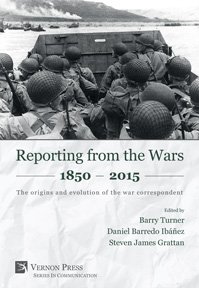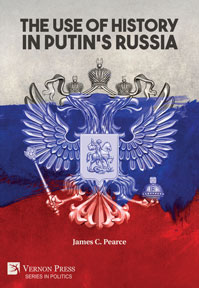The Red Warrior: U.S. Perceptions of Stalin’s Strategic Role in the Allied Journey to Victory in The Second World War
by Reagan Fancher (Texas Woman’s University)
Purchase this book
(click here to change currency)
Although most Americans believe that the United States was almost entirely responsible for defeating Hitler and the German Army in World War II, the Soviet Union also played a crucial role, marking a point of relative cooperation in the complex and fragile relationship between the two powers. [...] This well documented book explains the origin, effectiveness, and results of the Lend-Lease Act of 1941. [...]
The author sheds light on the impact of U.S. aid to Stalin during World War II. Since the focus of the book is on American insights, the author uses English language sources as well as materials translated from Russian. No doubt this valuable contribution regarding U.S.-Soviet relations will spark further research on this compelling topic.
Dr. Monica Bontty
History Professor
The University of Louisiana Monroe
Reagan Fancher’s “The Red Warrior: U.S. Perceptions of Stalin’s Strategic Role in the Allied Journey to Victory in The Second World War” will draw attention from readers interested in World War II as well as American-Russian relations. His book points out that while, on the one hand, American aid to the Stalin’s Red Army proved essential to winning the war against Hitler, on the other hand, this aid unfortunately promoted Soviet expansion of communist influence in Eastern Europe and Asia after World War II. In addition, Fancher’s book explores the importance of Soviet espionage and infiltration of the Roosevelt administration, significant aspects of American-Soviet wartime relations that are sometimes overlooked by other historians. Also, Fancher’s work does a particularly good job discussing American misperceptions of Stalin, connecting them to the “American way of war” when it came to the fight against Hitler. For those interested in the Cold War and post-Cold War conflict with Russia, Fancher relates the legacy of Lend-Lease to Ronald Reagan’s aid to the ‘mujahideen’ during the 1980s in Afghanistan, along with the current conflict between Russia and Ukraine. All-in-all, Fancher’s “The Red Warrior” proves to be a welcome addition to the bookshelf of any reader whose attention is drawn to studying a neglected but significant aspect of World War II as well as to an important factor in American-Soviet relations during the Cold War and beyond.
Dr. Ralph W Brown
History Professor
University of Louisiana Monroe
Before reading “The Red Warrior”, I would never have considered the World War II-era Lend-Lease Program a fascinating topic. Reagan Fancher manages to make it just that, describing how American fears regarding a separate peace between Nazi Germany and the Soviet Union compelled Roosevelt to drastically oversupply Stalin’s military in its struggle to resist Hitler. While Lend-Lease enabled the Soviets to defeat a common enemy, it also gave America’s duplicitous wartime ally the ability to transform itself into tyrannical superpower.
Dr. Jeffrey E Anderson
History Professor
University of Louisiana Monroe
Through U.S. President Franklin D. Roosevelt’s Lend-Lease program, American leaders sought to keep Joseph Stalin’s Red Army in the field and fighting Adolf Hitler’s forces in the Second World War from 1941 forward. Delivered by the Anglo-American Arctic naval convoys, overland through the Iranian deserts and mountains, and through the skies from Alaska to Siberia, this much-needed material aid helped Stalin’s Red Army to continue fighting and thereby prevented a separate peace with Hitler’s Germany and a mechanized repeat of the First World War’s Brest-Litovsk fiasco. Yet Roosevelt and other U.S. officials, due to their severe underestimation of Stalin’s character and his rigid and fanatical devotion to exporting Communism at gunpoint, gambled incorrectly that they could win the Soviet premier’s heart and mind through several excessive wartime aid gestures, including the furnishing of atomic bomb materials to the Soviet regime. By 1945, American leaders had succeeded in their strategic goal of keeping Stalin and his Red Army in the war and hastening victory but failed in their efforts to purchase the Soviet premier’s goodwill and commitment to postwar peace, heralding the global Cold War, and setting the stage for later U.S. martial aid programs to those resisting aggression abroad. In addition to its primary focus on the American leadership’s perceptions of Stalin’s strategic importance to the Allied war effort in the Second World War, this work also includes a detailed assessment of Roosevelt’s Soviet Lend-Lease program alongside U.S. President Ronald Reagan’s later support for the Afghan Islamic guerrillas resisting Soviet occupation during the Soviet-Afghan War of the 1980s and a comparison of both martial aid programs with Washington’s recent revival of Lend-Lease aid for the Ukrainian war effort. It offers today’s American leaders and policymakers a chance to consult the lessons of history and apply them in the present.
PREFACE
ACKNOWLEDGEMENTS
INTRODUCTION
CHAPTER 1 Brest-Litovsk’s ramifications, Wilson’s North Russian debacle, and the origins of American Lend-Lease aid to the Soviets
CHAPTER 2 U.S. perceptions of Hitler’s haughty hordes, Stalin’s struggling soldiers, and the Red Army’s rising resistance to the Nazis
CHAPTER 3 The triumphs and tragedies of the early Arctic convoys crews and the strategic expansion of the Persian Corridor and ALSIB
CHAPTER 4 About the late war Anglo-American Arctic convoys
CHAPTER 5 U.S. popular perceptions of Stalin’s Red Army and the impact of Soviet espionage and disinformation agents in undermining postwar peace prospects
CONCLUSION. A comparative analysis of Roosevelt’s Soviet Lend-Lease program and Reagan’s Operation Cyclone and the rebirth of Lend-Lease for Ukraine’s war effort
EPILOGUE. Uncle Sam’s arsenal of Stalinism – for better or worse
ABBREVIATIONS
AUTHOR’S NOTE
NOTES
BIBLIOGRAPHY
INDEX
Reagan Fancher earned his B.A. and M.A. degrees in History at the University of Louisiana at Monroe (ULM) and his Ph.D. in European History at the University of North Texas (UNT). His passion is spreading knowledge in the classroom and teaching the World History and U.S. History survey courses. Shorty after being accepted into UNT’s doctoral program in fall 2019, Fancher began researching the subject of U.S. Lend-Lease aid to the Soviet Union for his doctoral dissertation. In addition to 'The Red Warrior: U.S. Perceptions of Stalin’s Strategic Role in the Allied Journey to Victory in the Second World War', Fancher is also the author of the book 'The Holy Warrior: Osama Bin Laden and His Jihadi Journey in the Soviet-Afghan War' which he expanded in a second edition that was published by Vernon Press in 2023. He currently teaches a variety of history courses at Texas Woman’s University.
oversupply, oversupplying, excessive, extravagant military aid, extravagant war aid, Lend-Lease, Soviet Lend-Lease aid, Roosevelt’s approach, naivete, Stalin’s record of duplicity, Stalin’s duplicitous character, Eastern Front, Second World War, Lend-Lease supplies, Lend-Lease materials, Arctic convoys, Persian Corridor, Alaska-Siberia, ALSIB, Russell F. Weigley, Ulysses S. Grant, strategic approach, U.S. strategy, U.S. Second World War strategy, United States of American, Soviet Union, wartime relations, Communism, Red Army, Soviet Europe, Northeast Asia, Eastern Europe, Cold War, U.S. strategic interests, U.S. Second World War strategy, strategic success, strategic disaster, separate peace, Treaty of Brest-Litovsk, Second Brest-Litovsk
See also
Bibliographic Information
Book Title
The Red Warrior: U.S. Perceptions of Stalin’s Strategic Role in the Allied Journey to Victory in The Second World War
ISBN
979-8-8819-0007-6
Edition
1st
Number of pages
274
Physical size
236mm x 160mm








